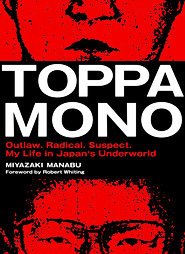
Today I finished reading Toppamono: Outlaw, Radical, Suspect. My Life in Japan's Underworld by Manabu Miyazaki. Its the story of the first 50 years of Miyazaki's life. Born into a Kyoto yakuza family Miyazaki has been a leftwing student radical at one of Japanese top universities in the turbulent '60s, a freelance journalist, head of his family's demolition firm, a bodyguard, a participant in the real estate boom of Japan's late '80s "bubble economy," and a suspect in one of Japan's most notorious extortion cases, the Glico Morinaga affair. Toppamono is his first hand account of these adventures and misadventures. Originally released in 1996 it sold more that 600 thousand copies in Japan, and has now been translated into English.
Its an entertaining book. Miyazaki makes no excuses and gives no apologies for spending much of his life on the wrong side of the law. He also provides a glimpse into a part of Japanese society unfamiliar to most foreigners, and probably unfamiliar to many Japanese. He became interested in Marxism as a teen and you can see hints of it in some of his comments on Japanese society and economic structure. Conversely his interest in Marxism may have been fostered by his yakuza background given that members of Japan's underclasses, ethnic Koreans and the traditional Burakumin "untouchables," frequently end up as yakuza given their limited opportunities in Japanese society. The reader is likely at times to shake their head and smile at the brazeness that Miyazaki often used in his business dealings, like selling the same load of scrap to two different people, or literally making a neighbouring gravel pit vanish when the one his firm was using ran out of materials.
One thing I would have liked was some pictures, especially of the immediate post war period of Miyazaki's childhood in Kyoto. It would have been especially helpful regarding a poignant scene when Miyazaki returned to Kyoto in the late '80s after a long absense. Getting off the train he found that the area around the train station, where he had spent much of his childhood, had been flattened and turned into a concrete barren by the very real estate speculation he was involved with at the time. It would also be interesting to be able to compare the Miyazaki of the mid '80s with the "Fox Eyed Man" sought by police in the Glico Morinaga case.
Oddly the book doesn't really go into the details of Miyazaki's adult family life. He was married to the same woman twice, and had at least one son with her, but they only come up when Miyazaki sent them to Tokyo during some of his legal troubles in 1980, and he sees his son's first day of school at an exclusive Tokyo grade school when it is shown on TV. Nor does he discuss whatever other romantic involvements he might have had. Perhaps his intent was to protect his family from public scrutiny regarding events they had no actual role in.
Despite these shortcomings Toppamono is recommended to anyone interested in Japanese culture beyond its traditional arts, high tech wonders, and glossy pop culture.
Miyazaki has official websites in both Japanese and English, although the English on the latter can be a bit funky.
No comments:
Post a Comment